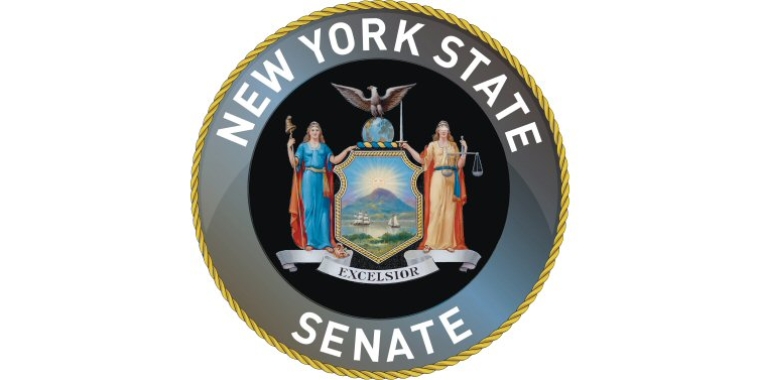
A Plan for Restarting New York
Sen. George Borrello and Assm. Andy Goodell
April 17, 2020

A Plan for Restarting New York
Senator George Borrello, 57th District Assemblyman Andy Goodell, 150th District
The restarting of New York’s economy should be phased in by region and by industry sector as quickly as possible consistent with appropriate CDC, OSHA, and other public health standards. The risk assessment for a region should be used to determine which business sectors can re-open and the appropriate level of public health screening and protective measures that should apply. The OSHA guidelines should be used to evaluate risk factors for different business sectors, and CDC standards should apply to each sector to minimize any adverse health implications. These factors are discussed below.
Regional Approach. The infection rate and risk factors for the COVID-19 outbreak vary widely across New York State. As indicated in the attached data, infection rates vary from 22.9/1000 in Rockland County to less than 0.3/1000 in Schuyler County. These infection rates reflect the fact that population density, utilization of mass transit, international travel, and other risk factors vary substantially between regions. New York City has the highest risk factors based on its high population density (over 66,000 people per square mile), normally crowded subways and buses, many international travelers, and inherent difficulty in maintaining social distancing. By contrast, rural upstate New York counties have low population density, little or no mass transit, and few overseas travelers. It should be no surprise that 94% of all infections were reported in New York City and the neighboring 5 counties. In addition, hospital utilization and available health care capacity varies between regions. While New York City was overwhelmed with hospitalizations, shortages of ventilators and personal protective equipment, and a need for temporary emergency hospital capacity, some of the other regions have few if any hospitalizations.
In developing a regional restart strategy, the existing ten regional economic development zones (EDZ) could be utilized as the basis for evaluating community risk levels, adjusted to reflect unique circumstances within the economic development zones. For example, Erie County, Monroe County, Onondaga County, and Albany County might be considered separately because their urban centers present unique risk factors. In addition, localized risk assessments might be appropriate to respond to localized hot spots.
Regional Risk Assessments. The State should consider multi-tiered risk assessment levels for the various regions. These regional risk assessments might be based on the following factors:
- Level of infection as measured by the number of active cases per thousand and the number of active cases per square mile (infectious density).
- Hospital utilization based on percent of local hospital beds utilized in response to the virus, percent of ICU capacity utilized for active cases, the percent of ventilators utilized, and the availability of staff and personal protective equipment.
- Regional demographic risk factors such as population density; inherent difficulty in maintaining social distancing because of reliance on mass transit, large apartment complexes, or high-density employment; concentration of homelessness population; extent of intrastate, interstate, or international travel; and other inherent risk factors.
- Trend data, such as the increase or decrease in the number of active cases, number of people in quarantine or isolation, and number of people hospitalized. The trend factor should be a net number, after deducting the number of recovered patients and those released from quarantine or isolation.
Regional Risk Levels. Current data indicates that the virus has dramatically impacted densely populated New York City, Long Island, and the nearby counties, overwhelming many of their health care facilities and resulting in thousands of deaths. Large portions of rural upstate, by contrast, have seen very few infections, with virtually no impact on their health care systems. While the virus knows no difference between urban or rural patients, the inherent differences in population density and other risk factors dramatically affect the spread of the virus. Based on current data (as of April 14, 2020), the regional risk assessment might be as follows:
Level 1. High Risk. New York City; Long Island; and Rockland, Westchester, and Orange counties in the Mid-Hudson economic development zone.
Level 2. Moderately High Risk. Mid-Hudson (except Rockland, Westchester, and Orange counties), Monroe County, and Erie County.
Level 3. Moderately Low Risk. Capital Region; Central New York; Broome, Steuben, Niagara, and Tompkins counties.
Level 4. Low Risk. All remaining economic development zones and counties not listed above. Map: New York State Department of Health, April 14, 2020
Business Sector Risk Analysis. OSHA has developed a business risk assessment model based on four levels, with corresponding guidelines for appropriate steps to protect workers, as follows:
Very high exposure risks- Health care workers, EMS, dentists, laboratory personnel, and others involved in aerosol generating procedures involving patients known or suspected of having COVID-19. The OSHA and CDC standards for this category will always remain very high regardless of regional risk assessments.
High Exposure Risks- Health care workers, medical transport workers, and mortuary workers involved in non-aerosol generating procedures involving patients known or suspected of having COVID-19. Again, these standards will always remain high because the patients are dangerous.
Medium Exposure Risks- Retail workers, school employees, bars and restaurants, golf courses, and high-density work environments that require frequent or close contact (within 6 feet) of people who might be infected. As regional risk assessments reduce, these businesses should be allowed to reopen, provided that the businesses comply with OSHA and CDC guidelines. Areas of public assembly, sporting areas, malls, and similar facilities could be reopened on a phased-in basis, with density restrictions and maximum capacity gradually increased. Required protective measures should gradually reduce as regional risk factors continue to drop.
Lower Exposure Risks- Office workers, manufacturing operations, golf courses, professionals (lawyers, accountants, land surveyors, architects, etc), and others who do not have frequent or close contact with others. These businesses should be allowed to reopen in lower risk regions, consistent with OSHA and CDC standards that maximize social distancing or “at-home” work, ensure routine cleaning of common areas, and provide appropriate protective masks or other protective equipment. These protective measures should gradually reduce as regional risk factors continue to drop.
See, Guidance on Preparing Workplaces for COVID-19, OSHA 3990-03 2020; CDC Interim Guidance for Businesses and Employers to Plan and Respond to Coronavirus Disease 2019.
Conclusion. Large portions of New York can be “open for business” consistent with appropriate health and safety protocols. It is essential that New York move as quickly and carefully as possible to restart the economy to minimize the long-term disruption to families and businesses, long-term loss of business customers to out-of-state competition, and the continued loss of State and local governmental revenues. While massive economic disruption might be warranted for high risk regions, the collateral economic damage to individuals, businesses, and local governments in low risk regions should be minimized.
The income tax, sales tax, and business tax revenues for New York State are currently in free fall as the result of the unprecedented closure of a substantial portion of the State economy. It is essential that effective steps be taken to safely restart the economy quickly to maximize the financial ability of the State and local governments to respond to COVID 19 and other critical funding needs.
A reasonable, balanced, and nuanced regional approach to restarting the economy is consistent with public health and economic development and will enable the supply chain to be gradually re-activated without being overwhelmed.
Share this Article or Press Release
Newsroom
Go to Newsroom
Repeal Bail Reform Task Force Visits Hudson Valley
March 12, 2020

Repeal Bail Reform Task Force Visits Hudson Valley
March 9, 2020

